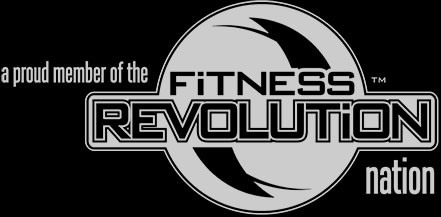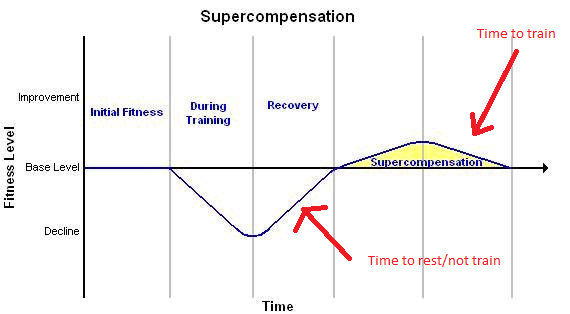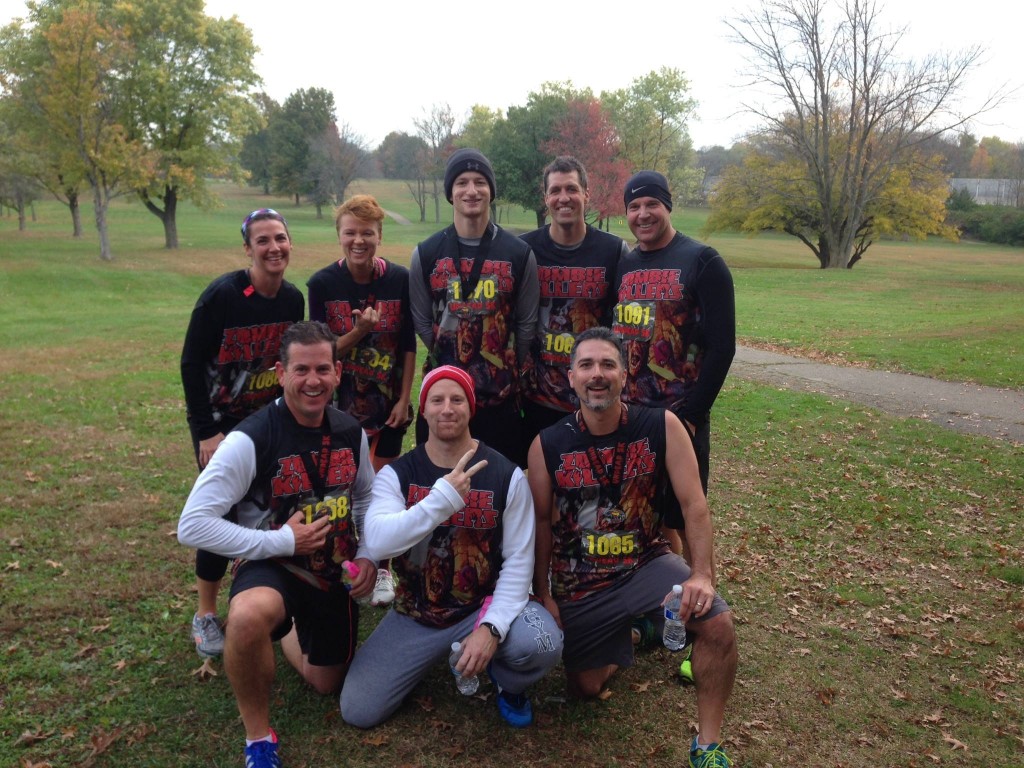Fitness can take on a different meaning for each of us. For some, it is simply a means to an end (looking better, being healthier…). For others, it is a way to improve athleticism. For me, it takes on several different meanings. My hope with this post is that you not only learn something about fitness and myself, but something new about yourself as well.
Fun. Fitness for me is fun. I enjoy going to the gym and putting myself through a tough 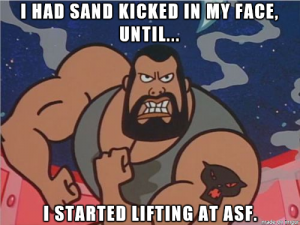 workout. The challenge of lifting a heavier weight or doing more reps than I did before is exciting and it brings me a lot of joy. Yes, I am one of those psychos that gets pure pleasure from the pain of the weight room. I imagine that if you workout at ASF you’re in the same boat.
workout. The challenge of lifting a heavier weight or doing more reps than I did before is exciting and it brings me a lot of joy. Yes, I am one of those psychos that gets pure pleasure from the pain of the weight room. I imagine that if you workout at ASF you’re in the same boat.
Investment. Fitness is a lifelong investment in my personal well-being. As a coach, I am always on my feet demonstrating different lifts, movements, drills, etc. therefore I am totally dependent on my body being able to perform. Making sure that I am doing the right things in the gym is an essential part of investing in myself.
Tough. Nobody ever said this stuff was easy. Loading up a barbell, placing it across your back, and deep squatting is tough stuff. It takes a certain mindset to not only go to the gym, but to do some work when you get there. Anybody that’s ever done a plate push knows that you better have your mind right or else you’re in for a world of hurt. If it was easy, everyone would do it.
Necessary. It is absolutely necessary for me to be active. I am naturally a bigger person and if I weren’t active I would blow up like a balloon. I wasn’t blessed with the genes of a LeBron James so I have to stay active and make a commitment to being fit. I’m sure many of you are in the same boat so it is absolutely necessary for us to do this together. Luckily, I love this stuff (and I think you do too, even if you don‘t know it yet) so it’s not that hard for me.
Emotional. I don’t know about you, but fitness is emotional for me-good and bad. The highs of lifting a personal record are coupled with the lows of feeling like crap and having an awful workout. Training isn’t only about moving your body. There is so much that happens from the neck up that it really is unbelievable. There’s a lot of blood, sweat, and tears that goes into training and if you don’t get emotional about it then you may not be totally invested in it. I am all in on fitness and it fires me up!
Stressful. This stuff can be stressful. Anybody that’s ever participated in a prowler relay knows what I’m talking about. Lifting weights, running, biking, or whatever is stressful- not only on your body, but mentally as well. If you’ve been training long enough, you’ve had that mental “burn-out” where you can’t imagine doing another set or another push or another sprint, but you do it because at the end of the day, success outweighs that stress.
Serene. Nothing clears the mind like getting underneath a barbell that’s loaded up with some serious weight and absolutely crushing it. Fitness to me is calming. It allows me to take all of the bottled up stress and release it. Anything that is or has been bothering me comes out in the weight room and wow, is it a relief!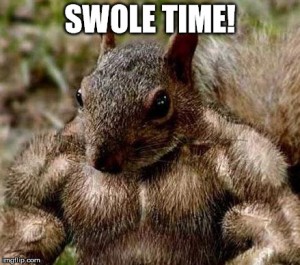
That’s what fitness means to me. A lot of people think it’s just a process of going to the gym, lift a few weights, and go home. For me (and the ASF family), it is so much more than that. It is a lifelong commitment to having fun, pushing past our “limits,” and just being awesome! Thanks for the read and if you get a chance, let me know what it means to you, I’d love to hear about it!
Author: adrensf
Lessons learned from 2014
Brian Macdonald:
- Everything helps everything. I heard this first from the one and only Tony Poggiali while he was coaching a team we were training at the time. Such a short phrase but it packs a huge punch. I really took this to heart and starting integrating it into my daily routine. For me, it all starts with simply waking up at a decent time and making the bed. This minuscule task already puts me in an improved mindset to be more productive around the house. Getting errands done around the house frees up time for continued education (research articles, podcasts, etc.). If you haven’t picked up on it, a chain reaction occurs. This has made me considerably more productive on a daily basis. A lot of times, the obstacle to get over is just getting started. Amazing how something as small as making the bed can change so much.
• It’s not about the money. Many people make the mistake of basing success, and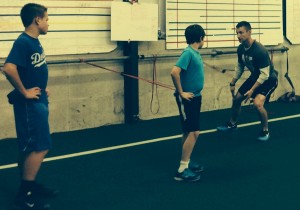 quality of life for that matter, off of their yearly income. Anyone who makes the leap into the strength and conditioning field knows (or should know) money is not the driving force. If you enter this profession with the aspiration of making six figures, you need to re-think your career path. Coaching is all about passion, you either have it or you don’t. If you don’t, it is not the career choice for you, because the athletes we train deserve everything we’ve got to give as a coach. They deserve a passionate coach who loves what they do and care deeply about making them a better person and athlete physically, mentally, and emotionally. I love what I do and legitimately care about my athletes and helping them excel as human beings.
quality of life for that matter, off of their yearly income. Anyone who makes the leap into the strength and conditioning field knows (or should know) money is not the driving force. If you enter this profession with the aspiration of making six figures, you need to re-think your career path. Coaching is all about passion, you either have it or you don’t. If you don’t, it is not the career choice for you, because the athletes we train deserve everything we’ve got to give as a coach. They deserve a passionate coach who loves what they do and care deeply about making them a better person and athlete physically, mentally, and emotionally. I love what I do and legitimately care about my athletes and helping them excel as human beings.
• I am incredibly lucky to be at Adrenaline Sports and Fitness. I literally can not envision myself doing anything but coaching. Not a day goes by which I am not thankful for the opportunity given to me by Tony to do what I love. He facilitates an environment that allows me to be myself and form my coaching style based on my personality. I truly respect Tony as a coach, business owner, and friend. He is an inspiration to the coach I hope to be someday.
• I am officially off the market. I married my beautiful wife October 10 and am an extremely happy man. I have so much respect for who my wife is and what she stands for. She drives me to better myself on a daily basis and keeps the structure I need in my life. I am a better person and coach because of her.
• I am just a big kid, and proud of it. In order to get through to our primary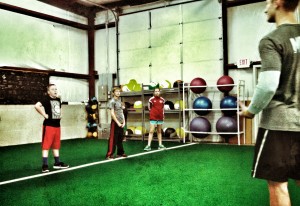 demographic (9-15), you have to be on their level to be able to communicate effectively. I can’t communicate with a 9 year old the same way I do with a 19 year old. That is common sense to most, but easier said than done.
demographic (9-15), you have to be on their level to be able to communicate effectively. I can’t communicate with a 9 year old the same way I do with a 19 year old. That is common sense to most, but easier said than done.
Neil Platt:
- Square pegs don’t fit in round holes. 2014 was a crazy year for me personally. I finished school, moved to Cincinnati, worked four different jobs, and finally found
where I want to be. All along the way I spent a lot of time trying to make things
happen rather than just letting them happen. We’re all guilty of this to some degree. Whether it’s trying to force relationships, make more money, get a better job, be
happier, and so on and so forth; all we really end up with is more frustration and less
of what we really want. This applies to our athletes as well. The same things (or
training protocols) don’t have the same effect for everyone. Not everyone will adapt or
improve from the same training stimulus, so it is up to us as coaches to realize
what is working and when/where changes need to be made rather than trying to force
all athletes to do the same thing. - Sometimes we need to meet athletes where they are. This applies to the

previous topic but I wanted to expand on this one a little more. There are times when
our athletes come in and you can tell right off the bat something is off; they
don’t have their usual bounce, or energy level. Keep in mind we normally work
with our athletes after they’ve spent an entire day being told what to do by their
teachers, parents, coaches, guardians, or whoever. This can wear on them mentally
and sometimes the last thing they want to do is come in and be told what do for
another hour. On those days, it is more beneficial for everyone if we meet the athlete where they are. Rather than trying to force them into a speed or heavy lifting
session, maybe those are days when a game day or mobility session would be more beneficial. Brian wrote a great article about the benefits of our game day’s so I’ll spare you all of the details, but the point is, even on days when we meet them where they are we can still get in a quality session. - Loaded carries and the associated variations were my favorite exercise of the year. I never really got into loaded carries as an exercise until this past year and I was really missing out. They’re super simple to do – just pick up something heavy and carry
it. Pretty difficult to screw it up but it’s challenging. Looking back at the different programs I wrote this year, I noticed I there was some variation into nearly every session. I love them not just for fitness enthusiasts but athletes as well. A majority of athletic events involve bracing yourself against either physical contact or gravity as a means of changing direction, jumping, landing, or moving somebody out of the way. A heavy carry forces you to activate nearly every muscle in your body to stabilize yourself and move. Having strong stabilizer muscles (such as your core and middle/upper back area) is a great way to help prevent against injuries and a heavy carry will help you achieve just that. - I’ve got along way to go to be the coach I want to be. I’ve worked as an assistant and intern for a few years before I became a full time coach and I can tell you that I’ve
got a long way to go. The experience I’ve gained in the few years I’ve been active
in this profession has taught me I know (almost) nothing. The road to becoming a successful coach is a long, winding, turbulent one that’s full of ups and downs and
twists and turns; but it’s these failures and successes that lead to more and more knowledge and in the end being a better coach. - I am doing what I’m supposed to be doing and I’m doing it where I’m supposed to. I have always been an avid sports fan and fitness enthusiast so the fact that I’m able to make a career out of it is mind blowing to me. I always knew I wanted to do something
in the sports/fitness world but I wasn’t sure what. Twenty-six years later I’ve found it, coaching. Every day is something different. Protocols and sessions may be the same
but it’s a new learning experience every day and I absolutely love it. I enjoy teaching
our athletes and seeing them progress day in and day out. There is nothing more gratifying to me than when a kid has that “ah-ha!” moment and they get it. All of the
hard work they put in has paid off and it all makes sense. Whether its how to cut
properly or proper form on a lift, I love every second of seeing them struggle and then
get it. Getting to work with the kids (and adults) at Adrenaline is something I am extremely grateful for. The support I get every day not just from Tony and Brian, but
the entire ASF family is amazing. You all make coming to work every day something I can’t wait to do. I look forward to seeing and continuing to build relationships with
all of you for many years to come!
Tony Poggiali
- There is no greater job in the world than being a coach. There, I said it. If you are a coach/teacher, you understand. If you are not a teacher/coach, it is a tough sell: long hours, no money, little praise, little to no job growth, etc. BUT, if you want to MAKE A DIFFERENCE, if you want to make young boys and girls into men and women of high character, develop into unbelievable fathers and mothers, awesome sons and daughters, husbands and wives, brothers and sisters, and contributors to society, then coaching is the way to go! From one coach to another: WE LOVE YOU [icon name=”smile-o” class=””]!
- Many of you know my daughter. What you may not know is that there was a real chance we may have never met. Sin
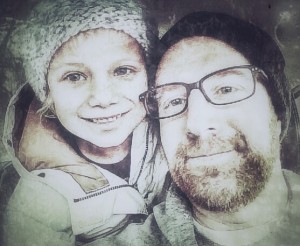 ce we did, and for the last six years, I have morphed into what, I hope, my legacy will become: The best father I can be. She is all I think about, and has taught me more than I could ever imagine. Those lessons of fatherhood have directly translated in to becoming a better coach.
ce we did, and for the last six years, I have morphed into what, I hope, my legacy will become: The best father I can be. She is all I think about, and has taught me more than I could ever imagine. Those lessons of fatherhood have directly translated in to becoming a better coach. - Along those same lines, I have never wanted to know so much about so much. The process of learning is just as fun as the outcome itself: the acquisition of something new. This profession is so dynamic, and what you think you know one day may change the next. Over my 26 years of coaching, my training philosophy has changed multiple times, thanks to this maniacal curiosity to learn. Now, I have come to the conclusion that knowledge is the accrual of information, while wisdom is the discarding of information; the latter being the state of knowing what you don’t know.
- Running a business is, by far, the hardest thing I have ever undertaken. Grinding every day just to break even has become a daily ritual. While we had our best year ever in 2014, I am still striving to become better, as a business owner, who happens
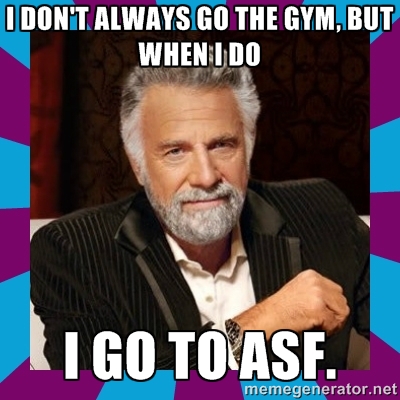 to coach (not the other way around). To the outside world, it looks pretty fun, and it is, but it can be brutal and keep you up many nights.
to coach (not the other way around). To the outside world, it looks pretty fun, and it is, but it can be brutal and keep you up many nights. - Without a great team around you, you will fail. From the past coaches, to the current coaches, to the behind the scenes ladies who keep me in line (Thanks Suzanne and Becky!!), and to each of you who have become our/my second family, this is the reason ASF is a great place. We believe there is “awesomeness” in each of you that step foot in these four walls and appreciate the opportunity that you have allowed us to share. Thanks for reading.
What you learn on the way to single-digit body fat… (part one)
For many of you, reducing your current body fat levels is a major goal. While everyone is unique, the post below will give some bullet points that apply to everyone on that path….
What Bodybuilding Competitions taught me about Nutrition
- It starts with discipline and desire. If you want something bad enough, you will discipline yourself to succeed.
- Physique changes are at least 80% directly related to nutrition.
- Once you can dial in your genetic predisposition, your nutrition can be much more individualized. For
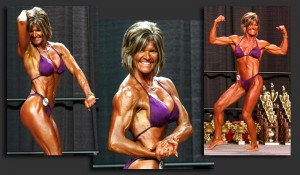
Susan Ball was in her late forties when these were taken. What a bod! example, as a predominantly fast twitch person, higher carbohydrates, lower fat worked best for me. It may take some experimenting for this to work, but be patient.
- Getting lean is simple, but not easy.
- Training more is not the answer. Higher reps are not (always) the answer.
- Supplements are good, but not mandatory.
- Internal dialogue is the only friend/enemy you have.
- Food is what you see, smell and taste; nutrition is what happens next. Boring, but effective, strategy.
- There is no “best” way: What works for one person may not work for another. Also, what works for you one year may not work as well for you the following year. For my lowest recorded reading of 2.8% (I am not making that up – hydrostatic weighed, verified by my college professors), I ate the following six times per day for 8 weeks: Frosted Flakes, skim milk, 6 egg whites. About the closest thing to zero fat grams as possible. About 12 years later, I used a lower carb approach (<50 grams/day) to get to 4.3% with an additional 30 pounds of muscle.
- There needs to be some “discomfort” and hunger if you are to drop body fat. Not to be confused with misery [icon name=”smile-o” class=””], but if you feel awesome all the time, you will likely not achieve the numbers you are chasing.
For some, single digits is just not going to happen. Or, if it does, you are so miserable, it may not be worth it. It might be even harder to stay at single digits then it was to get there in the first place!
Ask yourself if it is worth all of the above just to get below 10% (or 15% for women)? Is it all really worth the sacrifice, or can you be happy with a little higher percentage and still love yourself? That seems like a contradictory statement, given the fact that I outlined some things to keep you on track towards the elusive single digit reading. However, loving yourself, inside and outside, is much more important than a number will ever be!
“The Other 23”: Recovery Strategies- Neil Platt
You’re physically and mentally tired. Muscles burn and joints ache. Your heart is still racing from the hour that was just spent training. Whether you worked on your strength, power, agility, speed, or just general fitness, you left it all out there. Now that the easy stuff is done, it’s time to get to work.! What? That’s right, what you do in the facility – all the blood, sweat, and tears – is the easy part. The hard part is what you do the other twenty-three hours of the day. How you spend your time between training sessions is what determines how successful your training will be. This is the time for rest and recovery and it begins the second that training ends.
Recovery between training session is the key to your success. This includes a long list of strategies to help you maximize your efforts. It includes nutrition, hydration, massage/myofascial release, and low intensity work.
- Proper nutrition is vital. Athletes and fitness enthusiasts alike need the right amount of calories, fats, protein, and carbohydrates to ensure adequate growth and repair following training. For a quick review of nutrition, I recommend you check out this quick list http://adrenalinesf.com/parents/nutrition-tips-athletes/.
- It would be great to be able to get a massage following a training session but this is hardly feasible for most of us. Instead, try “rolling out.” The pain felt while rolling across a piece of foam is only temporary and it’s well worth the feeling of relief after you are done. Getting stiff and sore muscles to loosen up can make a world of difference on your next training session.
- Low intensity work (like a mobility session) or some light cardiovascular work can also be a useful tool. Elevating the heart rate a little bit and getting some blood flow through sore muscle tissue can help clear some of the nasty by-products of training by the way, lactic acid does not cause muscle soreness). A light jog or bike ride can really help the legs feel fresh and remove that “heavy” feeling. Mobility is something everyone can benefit from utilizing. After most of our strength training days we will do some mobility work with the athletes. For those that are in-season with their sport and dealing with the daily grind of practice, we may even have them do a full training session of just mobility. It’ can be painful and unpleasant at the time but the muscles generally feel relaxed and a little more fresh upon completion.
One of the most important aspects of rest and recovery is activating your parasympathetic nervous system post-exercise. While you are training, your sympathetic nervous system is in full gear. Your sympathetic nervous system is basically your “fight or flight” system. It heightens arousal, pupils dilate, your respiratory rate increases, your heart beats faster and with more force, blood flow increases to your muscles and decreases to other organs, sweat glands become more active, and so on. This is great when you are training but it makes it very difficult to relax and recover. If your sympathetic nervous system is left on for too long, it can start to damage different systems throughout your body. On the other hand, your parasympathetic nervous system is essentially the opposite. It relaxes the body’s different systems. Respiration slows, your heart rate comes back to normal, sweating ceases, blood flow returns to normal. All of this is essential if you are going to recover fully from a training session. There are several different techniques for activating this system and finding the right one for you is an important aspect of your training. There are diaphragmatic breathing techniques (belly breathing) which focuses thought on deep, rhythmic breathing in a relaxed state to help clear the mind. Meditation to help focus the mind and reach a relaxed state works for some. Yoga and stretching has been shown to help some achieve this relaxation. Finding your own way to relax is crucial to your training success. Tony can be seen floating above his house in the lotus position.
The final piece to the puzzle is rest. Getting a proper amount of rest (sleep) is absolutely crucial for achieving optimal results. Sleep is when the good stuff happens. Neurological repair and growth occurs, mental fatigue is alleviated, positive hormonal changes occur (growth hormone actually spikes during sleep!), tissue repair and growth take place, and the list goes on and on. John O’Sullivan and Mark McClusky point out that sleep is the ultimate performance enhancing tool that nobody really takes advantage of (I highly recommend watching their conversation, it‘s insightful and very thought provoking). The amount of sleep needed differs from person to person, but the general consensus is somewhere between 7-9 hours.
Training, whether it be for athletics or general fitness, is not an easy thing. That’s why not everyone does it. Only a select few of you are willing to make the sacrifices necessary to do it. Time spent in the facility is a small piece of the puzzle, what you do with the other twenty-three hours is what makes you successful.
For those who are visual learners, check out this simple graph below. As you train, you drop below your base fitness level. As you rest and recover, you return to your base fitness level and even “overshoot” your original fitness level (“supercompensation”). This overshoot represents your improvement from training.
Effortless Action (or the concept of Wu-Wei)
Wu- Wei: The concept of Effortless Action
“If you can’t move, you can’t help us.”
Coaches may not say that exact quote, but that is the bottom line. Every sport revolves around the ability to move, including running, throwing, cutting, catching, pushing, pulling, crawling, climbing, etc. These primal, fundamental patterns are ingrained at young ages and nurtured throughout the developmental stages of pre-pubescence to professional levels. Why do some seem to move with little to no effort while others seem to struggle?
I can only offer this explanation as conjecture, but it seems that the more a kid plays, the earlier a kid plays, and the more variety of playing, the better athlete they tend to be. I have no scientific proof of this so don’t look for any references, but I have the luxury of our “lab” at ASF and anecdotal experience to lean on. For those of you who grew up in the 80’s and 90’s, you likely remember how your “training” was the backyard. There was always that one kid that was faster than you. In fact, it was my informal introduction to speed and agility: Small = fast…or you get destroyed! I am more and more convinced that it was those after school games that introduced young kids to the trifecta of early athletic exposure (young, frequency, variety). Those kids tend to be the best overall athletes as they get older and display Effortless Action when it comes to sport performance. For years, they were honing their skills to the point that everything appears to come easy. However, it only appears that way because of the years and years of Deliberate practice, albeit unintentional. They have reached a state loosely based on a concept called Wu-Wei, in which there appears to be a state of non-doing, non-effort. It is a concept that master musicians, among others, tend to display. They just seem to flow through a performance as if they are not even trying! It is an awesome sight to behold. What do you think? Is there anything that you can relate to this state of effortless action?
On a somewhat related thought, I love this quote from the great Vern Gambetta: Human motion is beautiful to observe. The older I get and the longer I coach the more I have a sense of wonder at the intricacies of the connections, rhythms, and varied tempos of running, jumping and throwing and all the various permutations. The bodies ability to constantly self-organize, to adjust according to the movement problem it has to solve is amazing. The wisdom of the body is wondrous and infinite; there are no limitations – just possibilities. As coaches we need to focus on the possibilities and take advantage if the wisdom of the body. Think connections and flow to facilitate what the body can do, don’t get in the way.
Why I Coach – Brian Macdonald
There is a question every individual should ask themselves regarding their profession: “Why do you do what you do”? After about 2.5 years, I’ve been able to formulate my own answer to this and feel very strongly about it regardless of the short amount of time I’ve been a coach. The answer is simple for me and there are two concrete reasons. First, the impact I can have on the athlete’s lives that I coach. My priority is obviously to make my athletes better in their given sport and to see results, but when a parent pulls me  aside and explains to me the positive impact I’ve had on the LIFE of their child, I simply can not put into words the satisfaction it gives me. I’m not talking just an impact physically, but an all around impact – physically, mentally, and emotionally. Second, the relationships I build with the athletes and adults. Many of the athletes I coach are like little brothers and sisters to me. I truly look forward to seeing them every day and each relationship I have built with them has made me a better person and coach. If anything, I owe thanks to the parents for giving me the opportunity to coach their child.
aside and explains to me the positive impact I’ve had on the LIFE of their child, I simply can not put into words the satisfaction it gives me. I’m not talking just an impact physically, but an all around impact – physically, mentally, and emotionally. Second, the relationships I build with the athletes and adults. Many of the athletes I coach are like little brothers and sisters to me. I truly look forward to seeing them every day and each relationship I have built with them has made me a better person and coach. If anything, I owe thanks to the parents for giving me the opportunity to coach their child.
Money is certainly important, but when I coach it is not about the money. Throughout my long journey in college, switching my major three times and seriously worried I wouldn’t find anything to do for the rest of my life, I knew one thing: I wanted to be in a position to help people and make a difference, and I am truly grateful for the opportunity I’ve been given to do just that. STAY ACTIVE!
Some thoughts on strength training for kids…
originally written on September 21, 2010.
I was recently watching a group of kids struggling the other day and was trying to figure out why. Was the drill too tough? Were they too tired? Did I not coach it correctly? As I left that night, I came to the conclusion that there could have been any number of reasons, but the fact that they were all physically not as strong as they should be stuck out more than anything else.
In looking at our program design layout, you will notice that we always perform strength and power training after our movement skills. Effective and efficient movement of the body is priority number one. However, I am convinced that movement patterns, especially speed, will only be reinforced and improved through gaining strength. So, I am going to modify our training protocols to include more strength than we have before.
Here are some thoughts as to why strength training is so good for young kids:
1) Before the onset of puberty and during puberty, the Central Nervous System can be thought of as mold-able, or plastic. It is still capable of being introduced to a stimulus, adapting and starting the process of changing relatively quickly. Older athletes and adults are capable of this also but not at the level of young children. These tools will form the foundation for which further changes can occur.
2) We can move a kid as we strengthen them. Typically, strength training is limited to the space of the equipment in use, but in our world of bands, sleds, climbing, crawling, etc, the movement patterns and the strength patterns happen simultaneously. An example would be a walking sled press instead of a bench press, or a sled march instead of a squat. That doesn’t mean we will not use those exercises, but there are options beside the traditional means.
3) While it is a cliche, balance of the body is important for performance and injury prevention. Generally, balance will involve front/back, side/side and top/bottom; it will not always mean an equal ratio, however. For instance, our baseball players will always perform 2 to 3 posterior upper body movements for every anterior movement. Runners may perform more hip extension than hip flexion. Jiu Jitsu players and wrestlers may do core work on their backs more often than a football player. Once the body is looked at Generally, it can be broken down Specifically and Competitively based on the demands and needs of the sport.
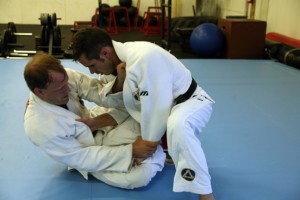
4) Strength, more than any other motor skill, seems to have the greatest transfer to improvements in all other motor skills. As strength improves, acceleration, deceleration, jump height, jump distance, and speed typically improve. Couple that with proper teaching of the mechanics of movement, and the athlete is poised to be a dangerous weapon.
5) Similar to #4, as strength improves, force production and force absorption also improve. Sports, in the big picture, rely on producing and absorbing forces, either into the ground, an object, or a person. Take running for example: As an athlete accelerates, he/she must be able to apply enough force into the ground to create the desired speed over a desired distance. If they are not strong (enough), they will not get to where the want to go as fast as they should (this is a very simple overview). Conversely, if they need to decelerate and change direction, they must be able to control their bodyweight, absorb any forces needed and slow down momentum, and possibly re-accelerate.
6) Many times strength is measured by how much an athlete lifts in the weight room, and rightly so. If Athlete A squats 400 and Athlete B squats 300, Athlete A is stronger…or is he? In powerlifting, that is true. Weight room strength is a tool that must be able to transfer into sport. Much has been debated about how weightlifters and powerlifters can hang with sprinters for the first10-20 yards of a race based on their strength levels, but don’t win the race. That is for another time, but strength for strength’s sake is only as good as the degree of transfer. Athletes should see a positive correlation between improved strength and improved performance. Also of importance is the concept of relative strength. There are a few interpretations of relative strength:
* Strength relative to bodyweight;
* Strength relative to their maximum or absolute strength (expressed as %1RM);
* Strength relative to the forces found within a given sport (ground reaction forces, for example).
Athletes obviously need both relative strength and absolute strength to be successful.
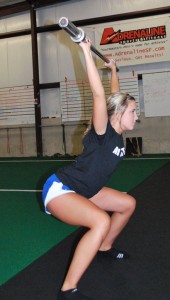
7) The variation of “stuff” that a kid can use to get stronger will yield more results than the traditional machines found in gyms. It is widely accepted that the more stimuli a child is exposed to, the greater the long term adaptations (which is why it is also a good idea to let your kids play as many sports as possible at a young age). The tools they get exposed to at ASF include:
* Dragging sleds
* Bands
* Medicine Balls
* Kettlebells/dumbells
* Tires
* Pneumatic resistance
* and of course bodyweight.
8) Puberty has a way of evening out the playing field at times; who was once the small, slow kid is now the fast, bigger kid. Once kids accept that puberty gives them the tools to get where they want to get, they can enjoy the process of learning how to do everything correctly. Personally, I was very small until 18 (135# as a senior in high school) and then in college put on muscle like I was on steroids! I know all of my years of free play and sports gave me the foundation to really take off (albeit after high school ended). So, parents and kids should trust in the natural, progressive way of the human body and be patient while building a neurological library of information.
9) Believe it or not, overweight kids thrive when it comes to strength training. It does not involve the things they are not good at, or do not like: running, jumping, teams, gym class, getting picked last in games, etc. It is one-on-one activity. The extra weight that has been a “burden” to this point actually prepares them to be somewhat stronger than average weight kids. I am not suggesting to become overweight to get stronger, but I am saying that if you cannot find the activity that suits you because of your size, try strength training. It will certainly lead to #10…
10) Let’s face it, getting stronger makes you perform better. It also improves your performa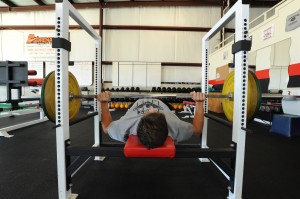 nce from the neck up by helping confidence, body image, self-esteem, discipline, pain tolerance and healthy competition (“what’s your bench?!”). I have seen kids in one hour improve their attitude just by increasing the amount of weight that they lifted compared to their previous session. That is priceless.
nce from the neck up by helping confidence, body image, self-esteem, discipline, pain tolerance and healthy competition (“what’s your bench?!”). I have seen kids in one hour improve their attitude just by increasing the amount of weight that they lifted compared to their previous session. That is priceless.
11) Similar to #10, I truly believe that kids can also become more aggressive with strength training. Sports are hard~physically, mentally and emotionally. Aggression can pull you through even the most challenging obstacles. Before I go further, my definition of aggression always involves sportsmanlike conduct, respect for the game and your opponents, and playing within the rules of the sport. Aggression does not imply fighting, cheating or bullying. It is a mental tool to use when needed: when you need to attack a defender, grab a loose ball, win the race, or always being ready. I use the word “aggression” quite often as I see more and more kids going through the motions but not really attacking that particular drill or exercise.
12) Finally, strength lays the foundation for longer term consequences. Statistically, most kids will not play sports in college and even fewer will become professional athletes. However, if strength training is introduced correctly at a young age, it can be done forever. Conversely, if it is used as punishment (“drop and give me 20!”), do you really think a child is going to want to do that voluntarily? We are in a position to affect not only the present, but the future and how healthy this generation becomes.
There you go….I am sure I missed a few, but these are the big ones. Now, GET STRONG!
Gameday!
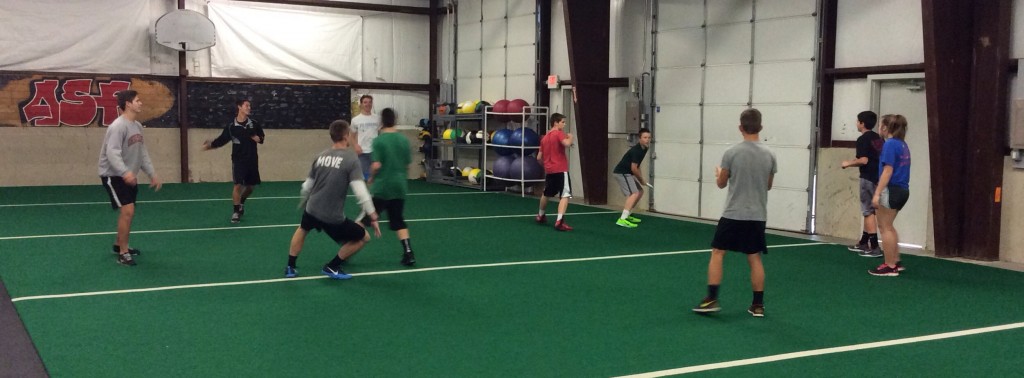 Every now and then, we will devote an entire training session to playing various games. While the casual observer may construe this as unproductive, a waste of time and a waste of money, we beg to differ. If you would like to read our rationale, this post by Brian Macdonald is for you…
Every now and then, we will devote an entire training session to playing various games. While the casual observer may construe this as unproductive, a waste of time and a waste of money, we beg to differ. If you would like to read our rationale, this post by Brian Macdonald is for you…
You, the parent, walk into Adrenaline a little earlier than you usually do to check and see how your kid is doing with their training. You walk in, and all you see is a game being played. You look at your watch and see there is still 30 minutes left; 30 minutes that should be devoted to hard work and training. Instead, it seems to just be play time. You think to yourself, “This is not what I am paying for. I expect to see sweat, yelling, and hard work.”
Undead 5k results from Team Zombie Killers
Brian Macdonald – 7th in age group (20-29)
Ben Helmers – 3rd in age group (35-39)
Brian Keto – 3rd in age group (40-44)
Brian Shearan – 5th in age group (40-44)
Jim Hahn – 8th in age group (40-44)
Tony Poggiali – 6th in age group (45-49)
Amanda West – 2nd in age group (30-34)
Becky Parnell – 1ST IN AGE GROUP!!!! (40-44)
Core Values
This will not be another core exercises article. There are enough of those. The following represent our Core Values. As coaches, what you stand for is arguably more important than what you know. Here are the ASF Core Values:
1. Seek Continuous Improvement – Good Enough isn’t Good Enough.
2. Have Fun and Laugh Often.
3. Strive to Make a Difference with Each Person.
4. Sweat the Small Stuff – Everything Matters.
5. Communicate Your Thoughts.
6. Enjoy Your Work.
7. Have only Good Days and Great Days.
8. Underpromise and Overdeliver.
9. Care – It’s Not That Complicated.
10. Coach When Needed; Listen When Needed.
11. Have Integrity, Passion and Pride in What You Do.
12. Practice Humility – Know What You Know and Know What You Don’t Know.
13. Embrace Your Role as a Coach – You are in a More Powerful Position than You Realize.
14. Evolve as a Coach – Critically Analyze New Ideas and Concepts and Determine Their Value and Place.
15. Be (a) Professional.
16. Practice Productivity: Help as many people as possible in as many ways as possible as often as possible.

